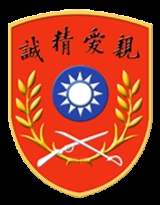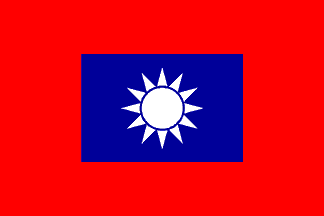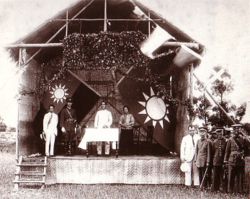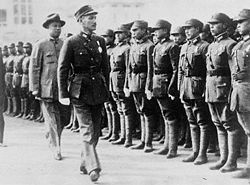
Whampoa Military Academy
Encyclopedia

Military academy
A military academy or service academy is an educational institution which prepares candidates for service in the officer corps of the army, the navy, air force or coast guard, which normally provides education in a service environment, the exact definition depending on the country concerned.Three...
in the Republic of China
Republic of China
The Republic of China , commonly known as Taiwan , is a unitary sovereign state located in East Asia. Originally based in mainland China, the Republic of China currently governs the island of Taiwan , which forms over 99% of its current territory, as well as Penghu, Kinmen, Matsu and other minor...
(ROC) that produced many prestigious commanders who fought in many of China's conflicts in the 20th century, notably the Northern Expedition, the Second Sino-Japanese War
Second Sino-Japanese War
The Second Sino-Japanese War was a military conflict fought primarily between the Republic of China and the Empire of Japan. From 1937 to 1941, China fought Japan with some economic help from Germany , the Soviet Union and the United States...
and the Chinese Civil War
Chinese Civil War
The Chinese Civil War was a civil war fought between the Kuomintang , the governing party of the Republic of China, and the Communist Party of China , for the control of China which eventually led to China's division into two Chinas, Republic of China and People's Republic of...
.
The military academy was officially opened on May 1, 1924 under the Kuomintang
Kuomintang
The Kuomintang of China , sometimes romanized as Guomindang via the Pinyin transcription system or GMD for short, and translated as the Chinese Nationalist Party is a founding and ruling political party of the Republic of China . Its guiding ideology is the Three Principles of the People, espoused...
(KMT), but the first lessons began on June 16, 1924. The inauguration was on Changzhou Island
Changzhou Island
Changzhou Island , also called Danes Island by the westerners, is an island in Huangpu District at the mouth of the Pearl River in East Guangzhou. It is about 11.5 square kilometers, of which the land area is 8.5 square kilometers. Its western part is linked to Guangzhou University Town by a bridge...
offshore from the Whampoa
Huangpu District, Guangzhou
Huangpu District is one of the ten districts in Guangzhou, Guangdong province, People's Republic of China.-History:...
dock in Guangzhou
Guangzhou
Guangzhou , known historically as Canton or Kwangchow, is the capital and largest city of the Guangdong province in the People's Republic of China. Located in southern China on the Pearl River, about north-northwest of Hong Kong, Guangzhou is a key national transportation hub and trading port...
, thus earning its common name. During the inaugural ceremonies, Sun Yat-sen
Sun Yat-sen
Sun Yat-sen was a Chinese doctor, revolutionary and political leader. As the foremost pioneer of Nationalist China, Sun is frequently referred to as the "Father of the Nation" , a view agreed upon by both the People's Republic of China and the Republic of China...
delivered a speech that was later to become the lyrics of the national anthem of the Republic of China
National Anthem of the Republic of China
"National Anthem of the Republic of China" is the current national anthem of the Republic of China .The Republic of China was recognized as the government of mainland China prior to 1949. Since then the Republic of China has controlled Taiwan and some other nearby islands...
.
Establishment


Yuan Shikai
Yuan Shikai was an important Chinese general and politician famous for his influence during the late Qing Dynasty, his role in the events leading up to the abdication of the last Qing Emperor of China, his autocratic rule as the second President of the Republic of China , and his short-lived...
, China fragmented into numerous fiefdoms ruled by warlords. Sun Yat-sen
Sun Yat-sen
Sun Yat-sen was a Chinese doctor, revolutionary and political leader. As the foremost pioneer of Nationalist China, Sun is frequently referred to as the "Father of the Nation" , a view agreed upon by both the People's Republic of China and the Republic of China...
attempted in 1917 and 1920 to set up a base in his native Guangdong
Guangdong
Guangdong is a province on the South China Sea coast of the People's Republic of China. The province was previously often written with the alternative English name Kwangtung Province...
to launch a northern campaign to unite China under his Three Principles of the People
Three Principles of the People
The Three Principles of the People, also translated as Three People's Principles, or collectively San-min Doctrine, is a political philosophy developed by Sun Yat-sen as part of a philosophy to make China a free, prosperous, and powerful nation...
. However, his government remained militarily weaker than local warlords armies. Calls by Sun for arms and money were ignored by the western powers. Then in 1921 the representative of Comintern
Comintern
The Communist International, abbreviated as Comintern, also known as the Third International, was an international communist organization initiated in Moscow during March 1919...
, Henk Sneevliet
Henk Sneevliet
Hendricus Josephus Franciscus Marie Sneevliet, known as Henk Sneevliet or the pseudonym Maring , was a Dutch Communist, who was active in both the Netherlands and the Dutch East-Indies...
(using the name Maring), met with Sun in Guangxi
Guangxi
Guangxi, formerly romanized Kwangsi, is a province of southern China along its border with Vietnam. In 1958, it became the Guangxi Zhuang Autonomous Region of the People's Republic of China, a region with special privileges created specifically for the Zhuang people.Guangxi's location, in...
. He proposed to set up a military academy and train the revolutionary army, which confirmed Sun's ideas and he eventually accepted. The Chinese Communist Party sent Li Dazhao
Li Dazhao
Li Dazhao was a Chinese intellectual who co-founded the Communist Party of China with Chen Duxiu in 1921.-Early life:...
and Lin Boqu
Lin Boqu
Lin Boqu ranked 8th in the 8th Politburo of the Communist Party of China. He was born in Hunan and was a follower of Sun Yatsen, but also joined the Communist Party of China in 1921. He participated in the development of Latinxua Sin Wenz....
(林伯渠) to discuss with Sun and his party on how to set up this academy. In 1924, in the 1st National Congress of Kuomintang
Kuomintang
The Kuomintang of China , sometimes romanized as Guomindang via the Pinyin transcription system or GMD for short, and translated as the Chinese Nationalist Party is a founding and ruling political party of the Republic of China . Its guiding ideology is the Three Principles of the People, espoused...
, the policy of alliance with the Soviet Union
Soviet Union
The Soviet Union , officially the Union of Soviet Socialist Republics , was a constitutionally socialist state that existed in Eurasia between 1922 and 1991....
and CCP was passed as guidance for KMT. As a result, the final decision of establishment of a military academy was made and preparatory committee was set up accordingly. The money necessary for the construction and support of the Academy in 1924-1925 was provided by the Soviets.
Organization, Training and Students

The academy concentrated the revolutionary military talents at the time. Sun took the job of Premier of this academy in person although it was just an honorary title. Sun's favorite and rising star Chiang Kai-shek
Chiang Kai-shek
Chiang Kai-shek was a political and military leader of 20th century China. He is known as Jiǎng Jièshí or Jiǎng Zhōngzhèng in Mandarin....
was appointed the first commandant of the academy. Liao Zhongkai (廖仲愷), the famous leftist of Kuomintang
Kuomintang
The Kuomintang of China , sometimes romanized as Guomindang via the Pinyin transcription system or GMD for short, and translated as the Chinese Nationalist Party is a founding and ruling political party of the Republic of China . Its guiding ideology is the Three Principles of the People, espoused...
and Sun's treasury secretary, was appointed as representative of KMT to the academy. Zhou Enlai
Zhou Enlai
Zhou Enlai was the first Premier of the People's Republic of China, serving from October 1949 until his death in January 1976...
, Hu Han-min and Wang Ching-wei were among the instructors in the political department. He Yingqin
He Yingqin
He Yingqin , also spelled Ho Ying-chin, was one of the most senior generals of the Kuomintang during Republican China, and a close ally of Chiang Kai-shek.-Early years:A native of Guizhou, He was healthy and bookish in his childhood...
and Ye Jianying
Ye Jianying
Ye Jianying was a Chinese communist general and the chairman of the Standing Committee of the National People's Congress from 1978 to 1983.-Biography:...
were once military instructors.
The serious lack of expert teachers was the biggest problem for the Academy. That is why lectures delivered by Soviet officers were extremely popular among students. A.S. Bubnov, G.I. Gilev, M.I. Dratvin, S.N. Naumov prepared lectures which explained the development of military thought throughout human history and the division between western and Soviet schools of military thought.

Russian Civil War
The Russian Civil War was a multi-party war that occurred within the former Russian Empire after the Russian provisional government collapsed to the Soviets, under the domination of the Bolshevik party. Soviet forces first assumed power in Petrograd The Russian Civil War (1917–1923) was a...
. Among them were I. Vasilevich (Janovsky), N. Korneev, M. Nefedov, F. Kotov (Katyushin), P. Lunev, V. Akimov. Galina Kolchugina (wife of Vasily Blyukher
Vasily Blyukher
Vasily Konstantinovich Blyukher Vasily Konstantinovich Blyukher Vasily Konstantinovich Blyukher (also spelled Bliukher, Blücher, etc., , Soviet military commander, was among the prominent victims of Joseph Stalin's Great Purge of the late 1930s....
who was Commander-in-Chief of all Soviet volunteer forces sent to China) read a course of lectures on political agitation.
The first two groups of students prepared by the Academy became the core for the formation of the first two National Revolutionary Army
National Revolutionary Army
The National Revolutionary Army , pre-1928 sometimes shortened to 革命軍 or Revolutionary Army and between 1928-1947 as 國軍 or National Army was the Military Arm of the Kuomintang from 1925 until 1947, as well as the national army of the Republic of China during the KMT's period of party rule...
regiments (V.A. Stepanov was an advisor provided by the Soviet Union to help in this matter). The first two prepared groups of students included 500 officers, the third one had 800 officers and the fourth had 2000.
Legendary graduates included Communist commanders Lin Biao
Lin Biao
Lin Biao was a major Chinese Communist military leader who was pivotal in the communist victory in the Chinese Civil War, especially in Northeastern China...
, Xu Xiangqian
Xu Xiangqian
Xu Xiangqian was a Chinese communist military leader.-Biography:Xu was born in Wutai county, Shanxi province, China. He was admitted to the Whampoa Academy in 1924 and held various officer ranks in the National Revolutionary Army between 1925 and 1927...
, Zuo Quan (左權), Chen Geng
Chen Geng
Chen Geng was a Chinese communist military leader.-Early life:Born in Hunan province, Chen was second of 12 siblings. However, because his elder brother died early due to illness, Chen became the eldest son. His grandfather, Chen Yiqong was an officer in the imperial Chinese army and was rewarded...
(陳賡), and Nationalist commanders Chen Cheng
Chen Cheng
Chen Cheng , was a Chinese political and military leader, and one of the main National Revolutionary Army commanders during the Second Sino-Japanese War and the Chinese Civil War. After moving to Taiwan at the end of the Civil War, he served as the Governor of Taiwan Province, Vice President and...
, Du Yuming
Du Yuming
Du Yuming was a Kuomintang field commander active in the Sino-Japanese War theatre of World War II and in the Chinese Civil War from 1945 to 1949....
, Xue Yue
Xue Yue
Xue Yue was a Chinese Nationalist military general, nicknamed by Claire Lee Chennault of the Flying Tigers as the Patton of Asia.-Early Life and Career:...
, and Hu Zongnan
Hu Zongnan
Hu Zongnan , courtesy name Shoushan , native of Zhenhai, Ningbo, born May 16, 1896. A general in the National Revolutionary Army and then the Republic of China Army. Together with Chen Cheng and Tang Enbo, he formed the triumvirate of Chiang Kai-shek's most trusted generals during the Second...
. These young students first showed their training and courage in the war against local warlord and dissident of Sun, Chen Jiongming
Chen Jiongming
Chen Jiongming was a revolutionary figure in the early periods of the Republic of China. Chen Jiongming was born in 1878 at Haifeng, Guangdong, China....
(陳炯明), and later the unification of Guangdong province. Then they made greater contributions in the Northern Expedition.
The Muslim Ma clique
Ma clique
The Ma clique or Ma family warlords is a collective name for a group of Muslim warlords in Northwestern China who ruled the Chinese provinces of Qinghai, Gansu and Ningxia from the 1910s until 1949. There were 3 families in the Ma clique , each of them respectively controlled 3 areas, Gansu,...
General Ma Zhongying
Ma Zhongying
Ma Zhongying, also Ma Chung-ying was a Tungan Chinese Muslim warlord during the Warlord era of China. Ma Zhongying's birth name was Ma Buying . Zhongying was a warlord of Gansu province in China during the 1930s. He allied himself with the Kuomintang, which gave his soldiers an official...
, who commanded the 36th Division (National Revolutionary Army)
36th Division (National Revolutionary Army)
The 36th Division was a cavalry division in the National Revolutionary Army. It was created in 1932 by the Kuomintang for General Ma Zhongying, who was also its first commander. It was made almost entirely out of Hui Muslim troops, all of its officers were Hui, with a few thousand Uighurs forced...
, attended the Whampoa military academy in Nanjing
Nanjing
' is the capital of Jiangsu province in China and has a prominent place in Chinese history and culture, having been the capital of China on several occasions...
in 1929.
Influence

United States Military Academy
The United States Military Academy at West Point is a four-year coeducational federal service academy located at West Point, New York. The academy sits on scenic high ground overlooking the Hudson River, north of New York City...
, it has exhibited a broad influence on Chinese history. It not only supplied many military commanders for both the KMT and CCP, but also its graduates have much more influence on both parties' policies and governance. Especially for Chiang and KMT, the Whampoa Clique was pivotal for his governance. It competed with other cliques of KMT such as the New Guangxi Clique
New Guangxi clique
After the founding of the Republic of China, Guangxi served as the base for one of the most powerful warlord cliques of China: the Old Guangxi clique. Led by Lu Rongting and others, the clique was able to take control of neighbouring Hunan and Guangdong provinces as well...
led by Li Zongren
Li Zongren
Li Zongren or Li Tsung-jen , courtesy name Delin , was a prominent Guangxi warlord and Kuomintang military commander during the Northern Expedition, Second Sino-Japanese War and Chinese Civil War...
and Bai Chongxi
Bai Chongxi
Bai Chongxi , , also spelled Pai Chung-hsi, was a Chinese general in the National Revolutionary Army of the Republic of China and a prominent Chinese Nationalist Muslim leader. He was of Hui ethnicity and of the Muslim faith...
, CC Clique
CC Clique
The CC Clique, or Central Club Clique was one of the political factions within the Kuomintang , in the Republic of China...
led by Chen Lifu and Chen Guofu
Chen Guofu
Chen Guofu, or Chen Kuo-fu , was a Chinese politician in the Republic of China. He was born in Wuxing, Zhejiang, China . Chen Guofu joined the Tongmenghui in 1911. He participated in both the revolution against the Qing dynasty and the "second revolution" against Yuan Shikai...
, Politics Research Group led by Yang Yongtai (楊永泰) and Zhang Qun (張群). At the same time, when the CCP built its first Red Army
People's Liberation Army
The People's Liberation Army is the unified military organization of all land, sea, strategic missile and air forces of the People's Republic of China. The PLA was established on August 1, 1927 — celebrated annually as "PLA Day" — as the military arm of the Communist Party of China...
after the Nanchang Uprising
Nanchang Uprising
The Nanchang Uprising was the first major Kuomintang-Communist engagement of the Chinese Civil War, in order to counter the anti-communist purges by the Nationalist Party of China....
in 1927 most of its commanders were from Whampoa, and in the following two decades, the CCP trained its army in the Whampoa way.
The motto of the academy "Camaraderie" (親愛精誠, literally 'Fraternity, Dexterity, Sincerity') was proclaimed by Sun Yat-sen at the opening ceremonies. The irony is that during the Chinese Civil War
Chinese Civil War
The Chinese Civil War was a civil war fought between the Kuomintang , the governing party of the Republic of China, and the Communist Party of China , for the control of China which eventually led to China's division into two Chinas, Republic of China and People's Republic of...
both the commanders from KMT and CCP were trained and educated in Whampoa. They fought for different beliefs and ideals although they used to live and study together like brothers in arms.
The academy also had significant influence over the 20th century history of other Asian countries. The fourth term of the Academy saw students not only from all parts of China, but also from different parts of Asia enroll. For example, there were 30 Koreans among them. Some of them were brought up in China, others were active participants during the national liberation movement of Korea in 1917-1926 and emigrated to China later only to take up arms for struggle for freedom of their country after their education was over.
A large number of students were originally from Vietnam. This group was led by the exiled leader to-be of the Communist Party of Vietnam
Communist Party of Vietnam
The Communist Party of Vietnam , formally established in 1930, is the governing party of the nation of Vietnam. It is today the only legal political party in that country. Describing itself as Marxist-Leninist, the CPV is the directing component of a broader group of organizations known as the...
and future leader of the Vietnamese struggle for independence, Ho Chi Minh
Ho Chi Minh
Hồ Chí Minh , born Nguyễn Sinh Cung and also known as Nguyễn Ái Quốc, was a Vietnamese Marxist-Leninist revolutionary leader who was prime minister and president of the Democratic Republic of Vietnam...
.
Relocations

Nanjing
' is the capital of Jiangsu province in China and has a prominent place in Chinese history and culture, having been the capital of China on several occasions...
after the defeat of the warlords in 1928. The academy moved again to Chengdu
Chengdu
Chengdu , formerly transliterated Chengtu, is the capital of Sichuan province in Southwest China. It holds sub-provincial administrative status...
during the Japanese invasion.
Republic of China Military Academy
In 1950, after the Communist victory on mainland ChinaMainland China
Mainland China, the Chinese mainland or simply the mainland, is a geopolitical term that refers to the area under the jurisdiction of the People's Republic of China . According to the Taipei-based Mainland Affairs Council, the term excludes the PRC Special Administrative Regions of Hong Kong and...
and the establishment of the People's Republic of China
People's Republic of China
China , officially the People's Republic of China , is the most populous country in the world, with over 1.3 billion citizens. Located in East Asia, the country covers approximately 9.6 million square kilometres...
, the academy was re-established in Fengshan, Kaohsiung County
Kaohsiung County
Kaohsiung County was a county in southern Taiwan that enclosed but did not include Kaohsiung City. On December 25, 2010, the county merged with Kaohsiung City to form a single special municipality.- Administration :-External links:*...
(now part of Kaohsiung City, Taiwan
Taiwan
Taiwan , also known, especially in the past, as Formosa , is the largest island of the same-named island group of East Asia in the western Pacific Ocean and located off the southeastern coast of mainland China. The island forms over 99% of the current territory of the Republic of China following...
as the Chinese Military Academy (陸軍官校) and changed name in 2004 to the Military University. (軍官大學) The site of the original academy in Guangzhou
Guangzhou
Guangzhou , known historically as Canton or Kwangchow, is the capital and largest city of the Guangdong province in the People's Republic of China. Located in southern China on the Pearl River, about north-northwest of Hong Kong, Guangzhou is a key national transportation hub and trading port...
is now a museum.
See also
- National Revolutionary ArmyNational Revolutionary ArmyThe National Revolutionary Army , pre-1928 sometimes shortened to 革命軍 or Revolutionary Army and between 1928-1947 as 國軍 or National Army was the Military Arm of the Kuomintang from 1925 until 1947, as well as the national army of the Republic of China during the KMT's period of party rule...
- Chiang Kai-shekChiang Kai-shekChiang Kai-shek was a political and military leader of 20th century China. He is known as Jiǎng Jièshí or Jiǎng Zhōngzhèng in Mandarin....
- KuomintangKuomintangThe Kuomintang of China , sometimes romanized as Guomindang via the Pinyin transcription system or GMD for short, and translated as the Chinese Nationalist Party is a founding and ruling political party of the Republic of China . Its guiding ideology is the Three Principles of the People, espoused...
- Warlord eraWarlord eraThe Chinese Warlord Era was the period in the history of the Republic of China, from 1916 to 1928, when the country was divided among military cliques, a division that continued until the fall of the Nationalist government in the mainland China regions of Sichuan, Shanxi, Qinghai, Ningxia,...
- Sino-German cooperation
- History of the Republic of ChinaHistory of the Republic of ChinaThe History of the Republic of China begins after the Qing Dynasty in 1912, when the formation of the Republic of China put an end to over two thousand years of Imperial rule. The Qing Dynasty, also known as the Manchu Dynasty, ruled from 1644 to 1912...
- Military of the Republic of ChinaMilitary of the Republic of ChinaThe Republic of China Armed Forces encompass the Army, Navy, Air Force, and Military Police Force of the Republic of China . It is a military establishment, which accounted for 16.8% of the central budget in the fiscal year of 2003...
External links
- The Chinese Military Academy Official Website
- Audio file: RTHK broadcast in Cantonese
- Article: "China to Turn Site of KMT Military Academy into Tourist Spot" on the People's DailyPeople's DailyThe People's Daily is a daily newspaper in the People's Republic of China. The paper is an organ of the Central Committee of the Communist Party of China , published worldwide with a circulation of 3 to 4 million. In addition to its main Chinese-language edition, it has editions in English,...
website

